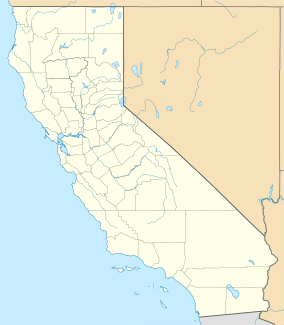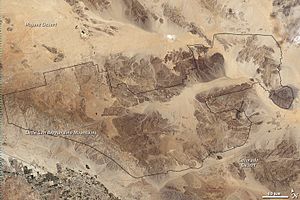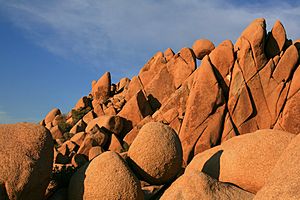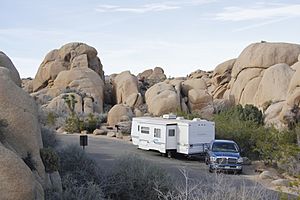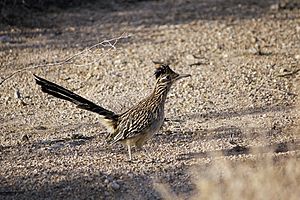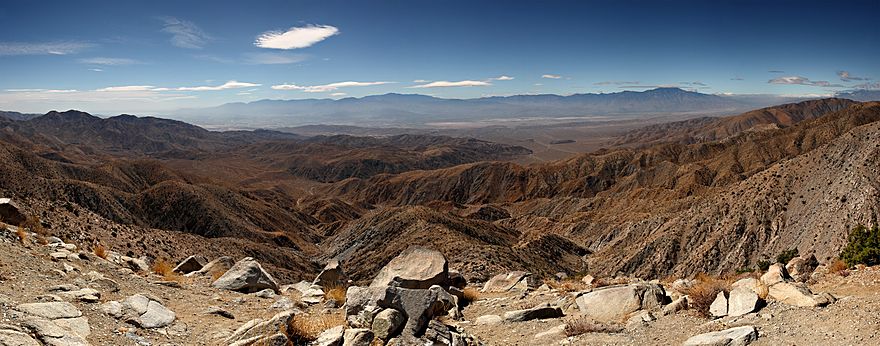Joshua Tree National Park facts for kids
Quick facts for kids Joshua Tree National Park |
|
|---|---|
|
IUCN Category II (National Park)
|
|
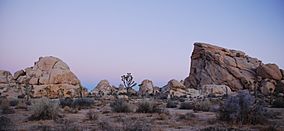
Cyclops and Pee Wee Formations near Hidden Valley Campground at dawn
|
|
| Location | Riverside County and San Bernardino County, California, United States |
| Nearest city | Twentynine Palms |
| Area | 790,636 acres (1,235.4 sq mi; 3,199.6 km2) |
| Established | October 31, 1994 |
| Visitors | 2,942,382 (in 2018) |
| Governing body | National Park Service |
| Website | Joshua Tree National Park |
Joshua Tree National Park is a special American national park located in southeastern California. It's found east of big cities like Los Angeles and San Bernardino, and close to Palm Springs. The park gets its name from the unique Joshua trees (Yucca brevifolia) that grow naturally in the Mojave Desert.
This area was first made a national monument in 1936. Later, in 1994, the U.S. Congress changed its status to a national park. The park covers a huge area of about 790,636 acres (1,235.4 sq mi; 3,199.6 km2), which is a bit bigger than the state of Rhode Island. A large part of this land, 429,690 acres (671.4 sq mi; 1,738.9 km2), is protected as wilderness.
Joshua Tree National Park is unique because it includes parts of two different deserts. These are the higher Mojave Desert and the lower Colorado Desert. Each desert has its own special plants and animals, mostly because of how high up they are. The Little San Bernardino Mountains also run along the park's southwestern edge.
Contents
Park History: A Journey Through Time
Early People and Explorers
The first people known to live in this area were the Pinto Culture, who were here between 8000 and 4000 BCE. They hunted and gathered plants. Later, the Serrano, Cahuilla, and Chemehuevi tribes lived here. They often settled near water sources, like the Oasis of Mara, which is now Twentynine Palms. These groups gathered plants for food and medicine, and hunted small animals. The Mojaves also used the area as they traveled. Today, descendants of these tribes still live near the park.
In 1772, Spanish explorers were the first Europeans to see the Joshua trees. Later, American fur trappers and explorers came through. After the Mexican–American War (1846–48), the United States took control of California, including this land.
Ranchers and Miners
Around 1870, settlers began grazing cattle in the park. Ranchers dug wells and built "tanks" to collect rainwater, like Barker Dam. This dam was built in 1900 and is now a historic site. Cattle grazing continued until 1945.
Miners also worked in the area from the 1860s to the 1940s. They dug about 300 small mines. The most successful was the Lost Horse Mine, which found a lot of gold and silver. Another important mine was the Desert Queen Mine on Keys' Desert Queen Ranch. These sites are now part of the park's history.
Protecting Joshua Tree
People realized how special this desert area was. In 1936, President Franklin D. Roosevelt used a law called the Antiquities Act to make Joshua Tree a national monument. This protected about 825,000 acres (1,289.1 sq mi; 3,338.7 km2) of land.
In 1950, some land was removed from the monument to allow more mining. But later, in 1994, the Desert Protection Act made it a national park and added more land back. In 2019, the park grew even more, adding 4,518 acres (7.1 sq mi; 18.3 km2).
Park Geography and Plants

Joshua Tree National Park is home to two different deserts, each with its own unique features.
The Mojave Desert
The higher and cooler Mojave Desert is where you'll find the famous Joshua trees. These trees can grow in dense groups or spread out far apart. The western part of the park, which is in the Mojave, has amazing rock formations. These are hills of bare rock broken into loose boulders, which are very popular for rock climbing. The flat areas between these rocks are covered with Joshua trees. The combination of the trees and boulders, like Skull Rock, makes the landscape look like something from another planet!
Temperatures here are best in spring and fall, around 85 °F (29 °C) during the day. Winters are cooler, around 60 °F (16 °C), with freezing nights. Sometimes, it even snows at higher elevations. Summers are very hot, often over 100 °F (38 °C) during the day.
Besides Joshua trees, you can find Pinyon pines, California juniper, and different kinds of desert oak trees among the rocks.
The Colorado Desert
The eastern part of the park, below 3,000 feet (910 m), is the Colorado Desert. This area has different plants like creosote bushes, ocotillos, and various cholla cactuses. Some areas have so many cholla cacti that they look like natural gardens!
The Coachella Valley is on the park's southeastern side, with sandy grasslands and desert dunes. The only palm tree native to California, the California fan palm (Washingtonia filifera), grows in five special oases in the park. These oases are rare spots where water is found all year, and many animals gather there.
Park Climate
Joshua Tree National Park has a hot desert climate. This means it's usually very dry and hot. The average lowest temperature in winter is around 19.8 °F (−6.8 °C).
| Climate data for Cottonwood Visitor Center, Joshua Tree National Park. Elev: 3104 ft (946 m) | |||||||||||||
|---|---|---|---|---|---|---|---|---|---|---|---|---|---|
| Month | Jan | Feb | Mar | Apr | May | Jun | Jul | Aug | Sep | Oct | Nov | Dec | Year |
| Mean daily maximum °F (°C) | 59.2 (15.1) |
61.1 (16.2) |
66.4 (19.1) |
75.3 (24.1) |
84.3 (29.1) |
92.8 (33.8) |
97.7 (36.5) |
96.7 (35.9) |
91.3 (32.9) |
80.0 (26.7) |
67.2 (19.6) |
58.6 (14.8) |
77.6 (25.3) |
| Daily mean °F (°C) | 47.2 (8.4) |
48.9 (9.4) |
53.3 (11.8) |
59.9 (15.5) |
68.2 (20.1) |
76.4 (24.7) |
82.4 (28.0) |
81.7 (27.6) |
75.7 (24.3) |
64.7 (18.2) |
53.7 (12.1) |
46.5 (8.1) |
63.3 (17.4) |
| Mean daily minimum °F (°C) | 35.1 (1.7) |
36.7 (2.6) |
40.3 (4.6) |
44.6 (7.0) |
52.1 (11.2) |
60.0 (15.6) |
67.0 (19.4) |
66.8 (19.3) |
60.1 (15.6) |
49.4 (9.7) |
40.1 (4.5) |
34.5 (1.4) |
49.0 (9.4) |
| Average precipitation inches (mm) | 0.88 (22) |
0.84 (21) |
0.66 (17) |
0.19 (4.8) |
0.07 (1.8) |
0.01 (0.25) |
0.32 (8.1) |
0.82 (21) |
0.26 (6.6) |
0.30 (7.6) |
0.32 (8.1) |
0.78 (20) |
5.45 (138) |
| Average relative humidity (%) | 40.7 | 43.0 | 42.9 | 37.4 | 35.1 | 26.2 | 28.6 | 31.0 | 30.1 | 31.4 | 34.6 | 37.9 | 37.9 |
| Average dew point °F (°C) | 24.5 (−4.2) |
27.4 (−2.6) |
31.3 (−0.4) |
33.8 (1.0) |
39.6 (4.2) |
39.2 (4.0) |
46.6 (8.1) |
48.1 (8.9) |
42.2 (5.7) |
33.7 (0.9) |
26.4 (−3.1) |
22.2 (−5.4) |
34.6 (1.4) |
| Source: PRISM Climate Group | |||||||||||||
Park Geology: Rocks and Mountains
The oldest rocks in the park are about 1.7 billion years old! You can see them in places like the Cottonwood and Pinto Mountains. Much later, volcanic material pushed up from underground, forming the granite rocks you see today.
Over time, water and wind wore away the softer rocks. This left behind the harder rocks, like granite, as big piles of rounded boulders. These famous rock piles are called inselbergs.
The park's mountains are part of the Transverse Ranges, which run east to west. The San Andreas Fault system, a major crack in the Earth's crust, helped create these mountains. Smaller faults, like the Pinto Fault, also run through the park and can cause earthquakes.
Fun Things to Do in the Park
Camping Adventures
There are nine campgrounds in the park. Two of them, Black Rock and Cottonwood, have water and flush toilets. You need to pay a fee to camp. You can reserve spots at some campgrounds from October to May. Other campgrounds are first-come, first-served. If you want to backpack, you can camp in the Backcountry with a few rules.
Hiking Trails
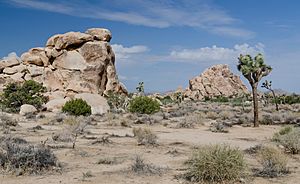
Many hiking trails are in the park. Short trails, like the one-mile hike through Hidden Valley, let you see the park's beauty easily. A long trail, the California Riding and Hiking Trail, goes for 35 miles (56 km) through the western part of the park.
At Keys View, you can see amazing sights. You can look out over the Coachella Valley, the Salton Sea, the San Andreas Fault, and the city of Palm Springs.
Some popular nature walks include:
- Hidden Valley
- Indian Cove
- Cholla Cactus Garden

Longer trails include:
- Boy Scout Hiking and Equestrian Trail
- Fortynine Palms Oasis
- Lost Horse Mine
- Lost Palms Oasis
- Ryan Mountain
It's important to know that some trails have been closed because of graffiti. Park officials want to protect these special places, including Native American sites.
Rock Climbing
Joshua Tree is a very popular place for rock climbing. Climbers love the thousands of routes, which have all levels of difficulty. The rocks are made of a rough type of granite, which makes for great climbing. The climbs are usually short, less than 230 ft (70 m) high. It's easy to walk to the climbing spots, so you can do many climbs in one day.
Some climbing routes are closed permanently or temporarily to protect wildlife. Always check with the park for current closures.
Visiting the Park
More and more people are visiting Joshua Tree National Park. The number of visitors more than doubled from 2013 to 2019. Many come to see the beautiful wildflowers in the spring.
You can drive on the paved main road to see the main attractions. Some unpaved roads might need a vehicle with high ground clearance or four-wheel drive. For example, the Geology Tour Road lets you take a self-guided tour to learn about the area's geology.
Birdwatching
Over 250 types of birds live in or visit the park! You can see desert birds like the greater roadrunner, cactus wren, and Gambel's quail. About 78 species even build nests and raise their young here. Many migrating birds stop at Joshua Tree to rest and eat, especially in winter.
Good places for birdwatching include the fan palm oases, Barker Dam, and Smith Water Canyon. Queen Valley and Lost Horse Valley are also great, with different kinds of birds like the ladder-backed woodpecker.
Stargazing and Astronomy
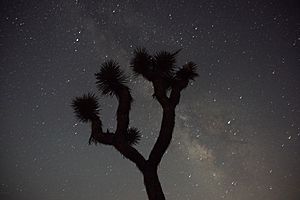
Joshua Tree is a fantastic place for amateur astronomy and stargazing. The park has naturally dark night skies because it's far from city lights. The high elevation and dry desert air also help make the sky clear for viewing stars.
On clear nights, especially around a new moon, you can see amazing things. In the eastern part of the park, the sky is so dark that you might even see the Andromeda galaxy and Triangulum galaxy with your own eyes! The central Milky Way looks very clear, and you might even see the zodiacal light, a faint glow in the sky.
Park Wildlife: Desert Creatures
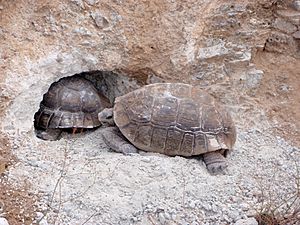
During the day, you're most likely to see birds, lizards, and ground squirrels. But at night, many other desert animals come out! These include snakes, bighorn sheep, kangaroo rats, coyotes, bobcats, and black-tailed jackrabbits.
The desert tortoise is a threatened reptile that lives in the Mojave Desert. These tortoises are amazing because they rarely drink water. Instead, they get most of their water from the plants they eat. Bobcats are important predators in the park.
You might also find the California tree frog near water sources. The red-spotted toad spends most of its life underground and appears after good rains. Golden eagles hunt in the park, and the roadrunner is a common sight. The call of Gambel's quail can often be heard.
Some interesting arthropods (insects and spiders) include the tarantula Aphonopelma iodium and the giant desert scorpion Hadrurus arizonensis. The yucca moth Tegeticula paradoxa is very important because it helps pollinate the Joshua trees.
Desert animals have special adaptations to live with little water and hot summers. Smaller mammals and all reptiles hide underground to escape the heat. Many animals also go into a state like hibernation during the winter. However, winter is a great time for birdwatching because many different species visit the park. A good place to see wildlife is at Barker Dam. You might even spot Desert bighorn sheep or mule deer there.
Wilderness Areas
A large part of Joshua Tree National Park, about 429,690 acres (671.4 sq mi; 1,738.9 km2), is designated as wilderness. This means it's a very protected area where nature is left wild.
If you plan to camp overnight in the wilderness, you need to register. You must use a camp stove because open campfires are not allowed. It's also important to follow "Leave No Trace" rules, which means you pack out everything you pack in. Bicycles are not allowed in wilderness areas, but horses are, with a permit. Cell phone service is often weak or non-existent, so don't rely on it for safety.
Protecting the Park from Vandalism
It's very important to protect national parks like Joshua Tree. Unfortunately, sometimes people damage the park by writing on rocks or cutting down trees. This is called vandalism.
Park officials work hard to stop vandalism and keep the park safe for everyone and for nature. They remind visitors to respect the park's rules and leave no trace. This helps make sure that future generations can enjoy the beauty of Joshua Tree National Park.
Images for kids
See also
 In Spanish: Parque nacional de Árboles de Josué para niños
In Spanish: Parque nacional de Árboles de Josué para niños


